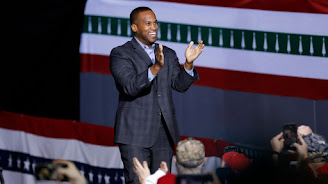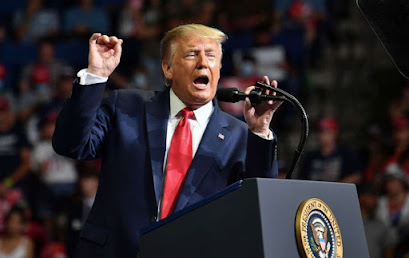Five Senate Seats Republicans Could Flip in 2020
With all of the talk about the contest between President Donald Trump and former Vice President Joe Biden, it is almost as if the United States Senate does not exist. In reality, the party that wins the Senate majority in 2020 will have the upper hand in Washington, D.C.—regardless of the victor in the presidential race.
If Trump wins reelection but the Republicans lose the Senate, he will find it difficult to confirm Cabinet secretaries, let alone federal judges. And, if Joe Biden wins the presidency but the Republicans keep the Senate, executive orders will be his only means for effecting an agenda.
If Trump wins reelection but the Republicans lose the Senate, he will find it difficult to confirm Cabinet secretaries, let alone federal judges. And, if Joe Biden wins the presidency but the Republicans keep the Senate, executive orders will be his only means for effecting an agenda.
The current betting odds suggest that each party will end up with 50 seats in the Senate. Because the vice president is technically the 101st senator (he casts tie-breaking votes), bettors are predicting that Senate control will come down to who wins the presidency. The RealClearPolitics no-tossup map, however, predicts that the Democrats will win an outright majority: 51 seats to 49 for the GOP.
These numbers are something of a letdown for the GOP, especially considering that they were heavily favored earlier in the cycle. However, Republicans may find some solace in five pickup opportunities: Michigan, Minnesota, New Hampshire, New Mexico, and Virginia. Republican Tommy Tuberville is widely expected to oust incumbent Democrat Doug Jones (D., Alabama), so it is not really worth analyzing that race.
Michigan:
The Wolverine State's Senate contest is the most regularly polled of this quintet, mainly because Michigan is a hotly-contested battleground state on the presidential level. In the Senate race, businessman John James is challenging incumbent Democrat Gary Peters. James is a 39-year-old West Point graduate who spent eight years in the Army—including as a fighter pilot in Iraq—before taking the helm of James Group International and increasing their annual revenues from $35 million to $137 million. Peters is a little-known career politician who has served in elected office since 1991.
 |
| John James (Newsweek) |
Lest Republicans get too excited about James's resume, they should keep in mind that he ran in 2018—a nationally Democratic year—and lost by 6.5 points. The open question is whether 2020 will be more like 2016 than 2018.
The three polls in the RCP average were conducted by EPIC-MRA, Change Research, and Gravis. Both EPIC-MRA and Gravis have Peters up by 10, but Change Research—polling on behalf of CNBC—has him up by only four. RCP calls the race a tossup. Nolan Finley, writing for the Detroit News, is far less optimistic: "John James is too good to waste. But I'm afraid that's what Republicans are doing by standing him one more time against a solid Democratic incumbent."
The race is probably somewhere in between a tossup (the CNBC/RCP position) and a solid Democratic race (the EPIC-MRA/Gravis/Finley position). That is not a bad place for James to be with three months to go.
Minnesota:
In 2016, Trump came within two points of winning Minnesota's 10 electoral votes. However, the Land of 10,000 Lakes was more favorable to the Democrats in 2018. Incumbent Democrats Amy Klobuchar and Tina Smith dispatched their GOP opponents handily, though Smith's battle was more closely-fought.
This time around, Smith is warding off a challenge from former U.S. Representative Jason Lewis, who was ousted by Democrat Angie Craig in 2018. Lewis's federal experience sets him apart from the 2018 Republican nominees, who were both Minnesota state legislators, and Smith is plagued by poor name recognition. However, Lewis—formerly a radio host—has made off-color comments, once suggesting that sexual harassment be protected on First-Amendment grounds.
 |
| Jason Lewis (BuzzFeed News) |
Lewis's chances were discounted early in the cycle, but two recent polls—conducted by the Democratic firm Public Policy Polling and Emerson College—show that he is a formidable challenger. PPP, a Democratic firm whose sample was overly friendly to Clinton voters, found that the race is in the single digits: 48% for Lewis to 39% for Smith. 13% of respondents were undecided.
Emerson College also found that Smith has the support of 48% of Minnesotans polled. However, they peg Lewis's support level at 45%—a deficit of just three points. Emerson's result is squarely within the margin of error and indicates that Smith has a tough race on her hands.
New Hampshire:
Like Minnesota, the Granite State almost voted for Trump in 2016 but narrowly went for Democratic nominee Hillary Clinton. Most prognosticators expect Trump to lose New Hampshire in 2020 but, if 2016 is any indication, the president will probably narrow the gap with Biden. This could bode poorly for incumbent Democrat Jeanne Shaheen, but she is benefitted by a late—and competitive—GOP primary.
On September 8th, the Republicans will choose between Corky Messner, an attorney and U.S. Army veteran, and Don Bolduc, a retired brigadier general who served in the U.S. Army Special Forces. Messner was endorsed by the president and leads in the two most recent polls. However, one of these surveys was conducted for the Messner campaign and the other—commissioned by Bolduc—shows that 73% of the primary voters are undecided.
Either way, Shaheen has an early advantage. The most recent poll from the University of New Hampshire pegs her support at 54% and her challengers' support at 35% apiece. That said, Bolduc seems to be a stronger general-election candidate: He reached 39% in two UNH surveys whereas Messner has never exceeded 37%.
RCP says that the race leans Democratic, which is a step above tossup status and two steps below solid Democratic status. This seems fair given Shaheen's early advantage. However, the race may tighten after the GOP primary, when the nominee will be able to consolidate support and focus his attacks on Shaheen instead of a fellow Republican.
New Mexico:
The New Mexico race is the most likely of this quintet to go for the Democrats, but it is worth putting on the list because of a combination of factors: support for Democrats is weak among New Mexicans, there is no incumbent, and the Republican nominee is relatively strong.
In 2016, Trump alone lost by more than eight points but the center-right won a plurality, with Trump plus Libertarian Gary Johnson commanding 49.3% of the vote. This becomes a majority if you include conservative independent Evan McMullin and the Constitution Party's Darrell Castle.
In the 2020 Senate race, the Democratic nominee is Ben Ray Luján, a U.S. representative who serves as the assistant Speaker of the House of Representatives. It is unclear whether these establishment bona fides will help or hurt Luján in the Land of Enchantment, but the Republicans will have a field day tying him to unpopular House Speaker Nancy Pelosi. In my opinion, the absence of an incumbent—or even someone previously elected on a statewide basis—is more relevant.
 |
| Mark Ronchetti (KRQE) |
This could be the opening for Republican Mark Ronchetti, who has name recognition as the former chief meteorologist for Albuquerque's CBS affiliate. As a pollster quoted by the Albuquerque Journal observed, New Mexicans have a history of electing people they first saw on TV: "Ken Schultz won the Albuquerque mayor's race after years on television in car sales advertisements. Casey Luna won lieutenant governor's race after being on television for years with advertisements for his car dealership."
The only poll of New Mexico, conducted by PPP, finds Luján up by 14 points. This seems decisive, but Luján does not command a majority, 18% of voters are undecided, and Trump voters were under-sampled relative to their participation in the 2016 election. New Mexico may be 2020's most surprising sleeper race.
Virginia:
Trump lost Virginia by a fairly large margin (5.4 points), though Democratic nominee Hillary Clinton fell just short of a majority. However, incumbent Democrat Mark Warner—who is up in 2020—barely held onto his seat back in 2014, beating Republican candidate Ed Gillespie by less than a point. In 2018, Republican Corey Stewart—a terrible candidate by any standard—cleared 41% of the vote in his bid against incumbent Democrat Tim Kaine.
Warner's biggest asset is that he is a relative moderate in a state that has been trending Democratic for two decades. Further, he is a household name in Virginia, having served as the state's governor (2002-06) and for two terms as their U.S. senator. Warner's experience could be a liability in an anti-establishment environment, but the statist instincts of Northern Virginia—practically a colony of Washington, D.C.—would easily overwhelm populist sentiments in the rest of the state.
 |
| Daniel Gade (N.Y. Times) |
Given Warner's strengths and the state's Democratic lean, you may ask: Why is Virginia on this list? The answer lies with Warner's Republican opponent, retired Lieutenant Colonel Daniel Gade. A graduate of West Point and the University of Georgia's Ph.D. program, he served in Iraq, lost a leg, and received two Purple Hearts. Gade has since become a vocal opponent of disability payments for retired service members, arguing that they cultivate dependency and dampen individual initiative.
RCP pegs this race as likely Democratic. However, RCP has not registered a single public poll of the race and, in 2014, Warner massively underperformed relative to public polls. On Election Day, Warner led by 9.7 points in the RCP average; he went on to win by just eight-tenths of a point.
Conclusion:
The Republicans are slightly down in the battle for the Senate but—thanks to their 53-47 majority—they are not out. Even if they were to lose their most endangered incumbents (Martha McSally of Arizona, Cory Gardner of Colorado, Susan Collins of Maine, and Thom Tillis of North Carolina) and the vice presidency, they could maintain an outright Senate majority by netting Alabama and one of the races that I list here.
Realistically speaking, resources are not infinite and Senate Majority Leader Mitch McConnell (R. Kentucky) likely wants to reserve money for races that he sees as winnable. However, the Democrats have shown a willingness to go on the offensive in red states, including Georgia, Kansas, Montana, and South Carolina. Republicans may fall short if they do not do the same.
McConnell could start by pulling John James and Jason Lewis over the finish line, and then eye New Hampshire, New Mexico, and Virginia.



Comments
Post a Comment